Belarus Tour Guide: Ideas for Your Trip!
Things to see in Vetka, an Old Believers refuge, major iconographic center
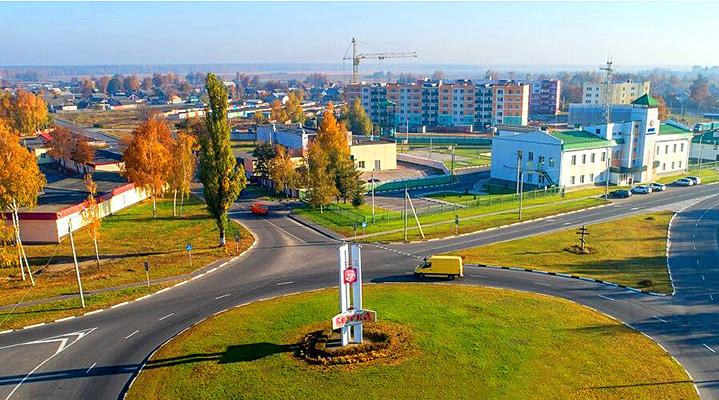
In the east of the Belarusian Polesie near the Sozh River stands the town of Vetka, once the abode of the Old Believers. The town traces its origins back to 1685 when believers from different parts of the Russian Tsardom (later the Empire), who did not accept Patriarch Nikon’s church reform, sought shelter on the outskirts and outside the state. That was how a new settlement emerged on the border lands of the Polish-Lithuanian Commonwealth near Gomel. Followers of the old tradition flocked to Vetka from all over Russia. Those were skilled artisans, iconographers, foundry men, scribes, wealthy merchants. The town was also mentioned by the famous poet Alexander Pushkin in his monograph The History of Pugachev where the protagonist Yemelyan Pugachev - the future leader of the peasant uprising - hid in the "schismatic settlement of Vetka".
A curious fact: literally during the first few years the population of the new town of the Old Believers exceeded 40,000. The population of Moscow was about 100,000 at that time.
There are several versions as to the origin of the name of the town. One gives an explanation that the small place, where the first settlers found refuge, got the name Vetka thanks to the nearby river, a "branch" or vetv of the Sozh River. Another interpretation suggests that Vetka was a "small branch [vetv] of Moscow", emphasizing the continuity of the Russian traditions of the Orthodox Church. A number of historians believe that a body of government in the Old Believers movement was called "vet" in the Old Russian language. In his essay Old Believers in Vetka (1907) ethnographer Ivan Abramov from St. Petersburg wrote: "Once in summer the elders from among the first settlers in Vetka sat down to think what to call the new settlement. A swarm of bees circled around them and settled on a branch [vetka]. "Let’s call our settlement Vetka," the elders decided. According to another beautiful legend, the Old Believers who fled from the capital attached an icon to a branch and floated it to the river: "The place this branch washes ashore will be our home, for this will be an indication of God's hand"...
It is known that the settlers received a charter of the Grand Duke and King of the Polish-Lithuanian Commonwealth, which guaranteed them religious independence and tax benefits. Nevertheless, the town maintained spiritual bond with Moscow: even the central square in Vetka was called Red Square. Although Peter I did not favor the schismatics, he still "commanded not to attack Vetka." In 1695, a church was erected here according to the traditions of the Old Believers. Vetka monks and priests carried gifts consecrated in this temple to many other Old Believers settlements.
In the 18th century the attitude towards the Old Believers changed again: by decrees of Empresses Anna Ioannovna and Elizaveta Petrovna, Vetka was burned twice by tsarist troops. But the town survived, preserving its traditions and culture. In the vicinity of the town there grew more than a dozen settlements of the Old Believers, which formed the Bolshaya Vetka agglomerate, one of the largest centers of the Old Believers in the 17th - 19th centuries. To this day, the town is known in Belarus and far beyond as a place of the priceless historical and cultural heritage.
Vetka is often called "fiery": it survived the burnings of the 18th century, numerous wars that swept through Belarus, and the Chernobyl. This image has been embodied in the unique "fiery" icons created by Belarus’ most famous iconographic center...
Merchant Groshikov’s house
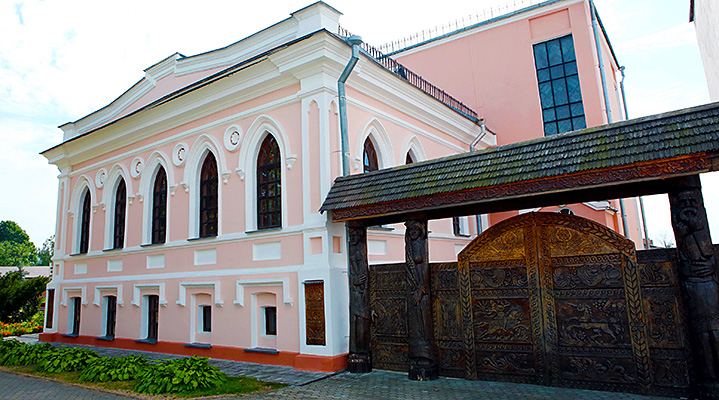
In the 18th -19th centuries, Vetka became not only a shelter for the Old Believers but also a major center of trade and crafts. At the end of the 19th century, the Groshikov family was the most respected family among merchants and shipowners. One of its most famous representatives was Timofei Groshikov. In 1897, he built a mansion matching his status: a two-story brick building in the Gothic style on a high plinth. Lancet windows were the main decorative element of the facade. The house had four halls united by one hallway. The largest hall – the living room – had five windows.
Today, the restored house of the Old Believer merchant Timofei Groshikov is included in the list of historical and cultural heritage of Belarus. Today the building houses the famous Shklyarov Museum of Old Believers and Belarusian Traditions.
Address: 5 Red Square
Shklyarov Vetka Museum of Old Believers and Belarusian Traditions
The museum in Vetka is, without exaggeration, a unique treasure trove of the country. It preserves the heritage of masters who used rare techniques of icon painting, book design, jewelry and blacksmithing. Visitors to the museum are amazed by folk art that intertwines the traditions of the Old Believers and the Orthodox Belarusian village.
The collection began with a private collection of Fyodor Shklyarov, a native of Vetka, who came from an Old Believer family, an artist and a collector of local heritage items. The permanent exhibition was opened in the house of the merchant Groshikov on 1 November 1987. The museum has gained international recognition and has more than 13,000 items.
The first floor runs the exhibitions "A Journey through the History of Vetka", "Forging shop", "Workshop of Goldsmiths". They narrate the history of the town and its legends. A special exposition is devoted to Vetka's forging traditions. It features products made by local artisans (gospel covers, icon cases), their professional and personal letters, working tools.
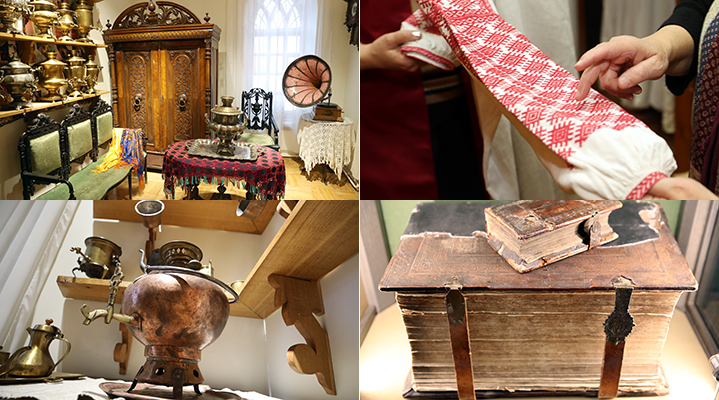
The exhibition on the second floor celebrates local weaving traditions. It displays traditional costumes and decorations native to the region, the unique weaving techniques of Vetka District. The Teahouse exposition is a rare collection of copper dishes and samovars. A separate hall is dedicated to the famous Vetka icon painting traditions featuring the icons of the Vetka and Babitsky Old Believers: “Archangel Michael Cathedral", "Intercession" from the Holy Intercession Church in Vetka, "Assumption" from the church in the village of Popsuyevka, Vetka District... The collection also presents artifacts of local decorative and applied art of the 17th - early 20th centuries: gold and beaded sewing, wood carving, embossing and engraving on metal.
The third floor is about books. It keeps handwritten and old printed editions of the 16th - early 19th centuries: “The Gospel" by Piotr Mstislavets, books by Ivan Fedorov (including the unique edition of the Apostle), Vasily Garaburda and Onisim Radishevsky, editions printed by Belarusian, Ukrainian and Moscow printing houses, books of Old Believers, illuminated gospels of the 16th - 17th centuries, manuscripts of the 16th - early 20th centuries, music manuscripts... The map "The Way of Books to Vetka” which is on display has been made based on records of books and gift deeds.
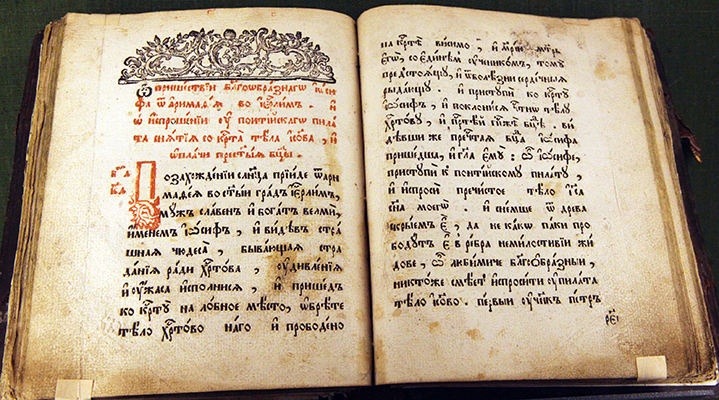
Address: 5 Red Square
Vetka icons
Centuries ago, Vetka icons turned from a local cultural landmark into a truly unique artistic phenomenon. Vetka icons are distinguished by a ‘flaming, fiery’ style of depicting saints’ faces, themes and details of the composition, remarkable floral ornaments, and the magnificent decoration of revetments. After many years of research, the concept of the ‘Vetka school of icon painting’ was introduced into scientific circulation.
Under the influence of the Baroque art and other popular Western European artistic trends, Vetka icon painting deviated from the canonical Byzantine traditions. The composition of icons incorporated interior design elements, costume details, everyday themes, which made the depicted saints look more ‘human’. Old Believers had to live an isolated life because they were persecuted for their faith. Yet, their world was joyful and optimistic, and their icons were a universe where beauty reigns. Vetka icons are elegant, multi-figured, full of images of people, flowers, herbs... Another remarkable feature of Vetka icons are highlighted places around saints’ mouth and chin, an unusual shape of an upper lip and a swollen, slightly bifurcated lower lip.
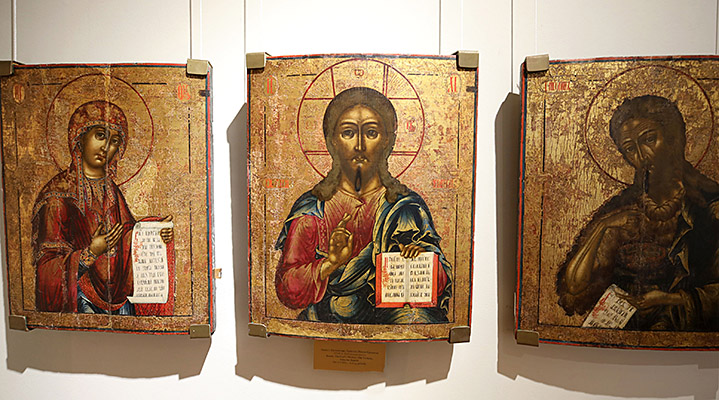
The image of the Garden of Eden was conveyed through striking floral ornaments. Local artisans painted roses and rose bouquets, branches with leaves and flowers of apple trees, acanthus leaves, vines, daffodils… The most dexterous icon painters used the techniques of linting and gold coloring.
The most popular wood species used for Vetka icons was poplar, which, unfortunately, is highly susceptible to pests. For this reason, most of the authentic icons from Vetka were riddled with holes made by grinder bugs. However, insect infestation did little damage to the images, as the boards were pretty thick, from 2 to 3 cm.
Icons from Vetka are remarkable not only for their lively images, but also for their opulent decoration. They were often adorned with revetments embroidered with multicolored beads (artisans were said to add pearls caught in the Sozh River), carved wooden icon cases covered with paint and goldish revetments. These revetments contained tiny little details depicting the interior of a temple.
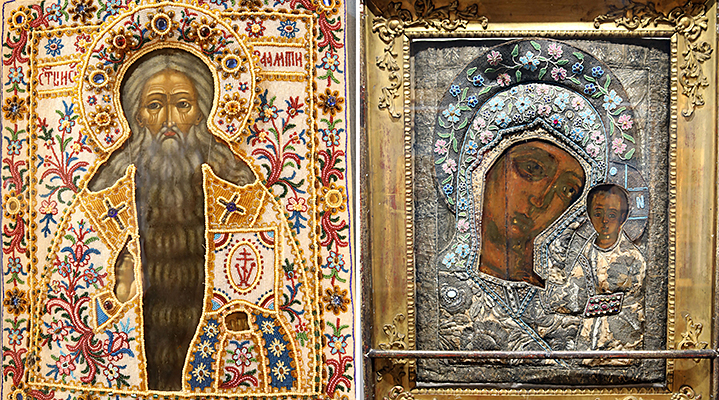
Visitors to the Vetka Museum of Old Believers and Belarusian Traditions can see how talented and skillful local icon painters, jewelers, blacksmiths, and wood carvers were. Numerous interpretations of the Mother of God with a fiery face, St. Nicholas who seems to be looking over the viewer’s left shoulder, driving away a demon, Archangel Michael the Voyevoda depicted as a fire-faced rider on a fiery winged horse – these are the symbolic images of Vetka icon painters, which impress with their insight and beauty…
Neglyubka towels in Vetka
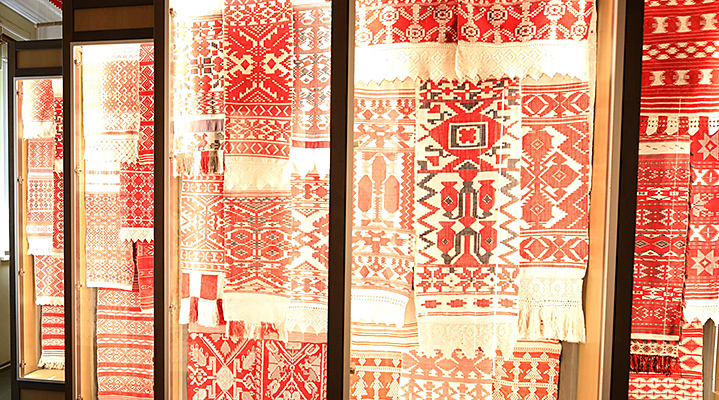
The weaving traditions of the village of Neglyubka in Vetka District are rightfully considered an asset of Belarusian arts and crafts. The Vetka Museum of Old Believers and Belarusian Traditions does not only showcase them, but also studies them thoroughly and deeply. The museum boasts the country’s largest collection of towels (3,500!). Most of them were woven by many generations of women from Neglyubka.
Created using a unique technique, Neglyubka towels were the highlights at many international events, they are a valuable part of museums and private collections in Europe and Asia. Some of them are kept at the Metropolitan Museum of Art in New York. The road to heaven - this is how hand-made towels have been called since ancient times, as they are believed to “speak” with higher forces in the language of ornament, accompanying a person from birth to death. Three colors of life - red, white and black - are intertwined in them. These colors stand for three eternal feelings of a human soul - love, joy and sadness.
People believed that these towels protected Neglyubka from the evil, and without them houses of the villagers would be defenseless and empty. It is noteworthy that Neglyubka was not affected by the Chernobyl accident while residents of other communities of the district had to be evacuated.
For many centuries, Neglyubka residents differed from other Poleshuks not only because of their tradition to decorate their houses with towels-symbols, but also because of their apparel. The women of the village even tied their beautiful hand-made scarves in a very different way. Today, Neglyubka traditional costumes are also on display in the Vetka Museum of Old Believers and Belarusian Traditions.
Vetka architectural carving
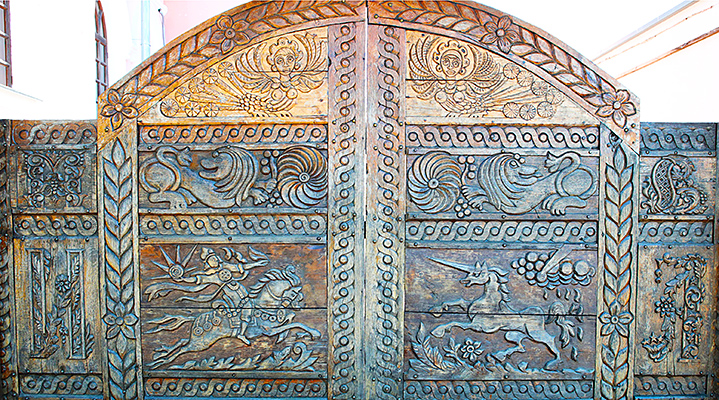
The Old Believers of Vetka used to say: my house is my temple. This means that they decorated their homes not only inside - with icons, old spiritual books, original pieces of furniture, but also outside. Entire scenes were depicted on windows, roofs and gates!
The decoration of houses with carvings, which became the hallmark of the town, was originally associated with the manufacture of elegant wooden icon cases. Artisans honed their carving skills on window frames and overlays, which are much larger than icons. After getting enough practice, artisans would proceed to such a delicate matter as icon-case carving. The art of creating wooden patterns was passed on from generation to generation. This art was distinguished by its techniques and floral motifs on gilded iconostases. It started to take root in the 17th century and has become a true intangible asset of Vetka District.
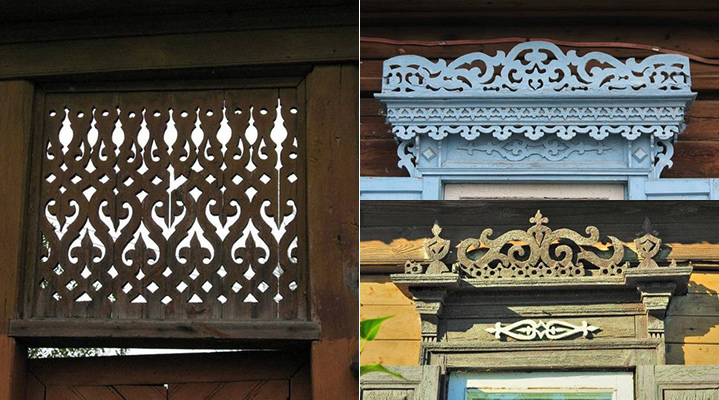
Today, the storerooms of the Vetka Museum of Old Believers and Belarusian Traditions (it is named after Fyodor Shklyarov who was a famous carver himself) are filled with house carvings. Fyodor Shklyarov and his students carefully removed these carvings from collapsing old houses, most of them after the Chernobyl disaster that prompted massive relocation of local residents. Thus, now Belarus’ largest collection of house carvings is kept in Vetka.
Vetka Old Believer Cemetery
The local cemetery is another iconic place of historical and cultural interest. The most remarkable part of it is the so-called Moscow Old Believers section. Mysterious boulders and bizarre granite sarcophagi were mounted here instead of tombstones. And most strikingly, almost all the monuments and eight-pointed crosses stand at the feet of the dead, on the eastern side, “so that when the dead come back from the other world, they will have something to lean on”, locals say. Gravestones have long been called windows: Vetka residents believed that angels rest on them or the souls of the dead “sit down” here.
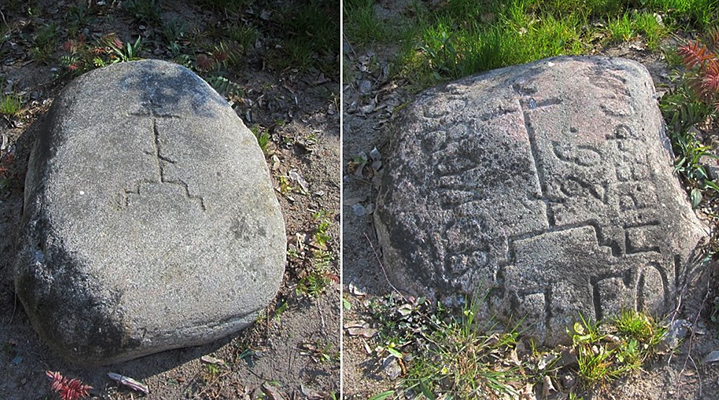
The oldest surviving tombstones date back to the late 18th – early 19th centuries, most of them - to the mid-19th century. Both wealthy merchants and ordinary people were buried here: judging by the grave monuments, the cemetery was not divided according to the principle of nobility or wealth. At the same time, at the beginning of the 20th century, it was in Vetka that wealthy people with Old Believer roots from Gomel were buried here.
Address: Lunacharsky Street
Staroye Selo settlement
Vetka and its suburbs are one of the richest in archaeological respect regions of Belarus. Local artifacts attracted the attention of researchers back in the second half of the 19th century, when an ancient settlement was found not far from the town.
The Staroye Selo settlement, also called Zamchishche, is an archaeological monument of Belarus. It is a hill with a flat top, which once was used as a fortification and from where today you can see not only the streets of Vetka but even the outlines of Gomel. Locals believe that it was built by the Swedes during the Great Northern War (early 18th century). However, after the large-scale excavations Belarusian scientists proved that the fortress might be one of the country’s oldest, erected back in the Bronze Age.
The settlement is known for its unusual layout. The fortified site is located in the center, not on the edge of the outlier (elevated land in the river floodplain), which is a traditional way to build. Historians and archaeologists still cannot find an answer who and for what reason erected such an unusual fortification, because it is known that it was almost never used. The excavations in Staroye Selo revealed more than 100 findings, including tools of labor and hunting (scrapers, piercing, points and flints), fragments of stucco with Indo-European symbols. However, no such artifacts were found in the settlement itself. There are versions that it was used as a temporary shelter for the inhabitants of the surrounding area, or the people who built it rapidly left their land and maybe died.
The Staroye Selo settlement in Vetka is often visited for another reason. According to local legends and stories of old-timers, two ox hides of silver and a barrel of gold are buried in this place.
Church of the Transfiguration of the Saviour
The first mention of the Orthodox parish of Vetka dates back to the 19th century. The Church of the Transfiguration of the Saviour was built in 1839 with the money of parishioners and benefactors. The church itself, as well as the bell tower and fence were built from wood, soon becoming a work of local architecture. The church operated several parochial schools, including in the surrounding villages, and had a library. Over time, the buildings fell into disrepair. During the Soviet time the parish was housed in a small chapel.
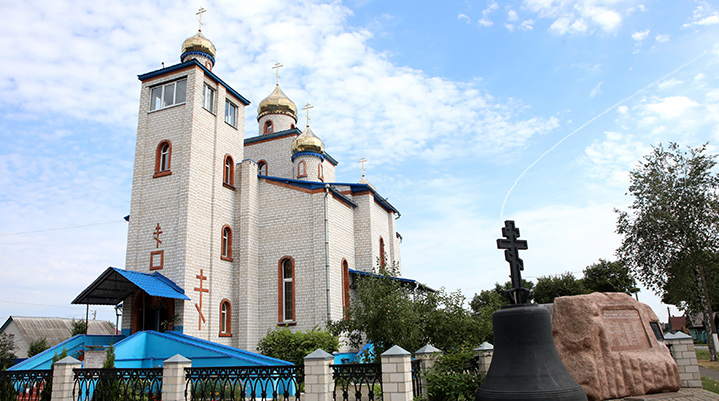
The Vetka community initiated the construction of a new church of the Transfiguration of the Savior in 1996. The construction was completed in September 2003. The church was consecrated by Metropolitan Filaret of Minsk and Slutsk, Patriarchal Exarch of All Belarus, and Archbishop Aristarkh of Gomel and Zhlobin. Since then regular services and celebrations have been held there. The vertical structure of the Church of the Transfiguration and its geometric shape differ from usual buildings. Thanks to its location in the center of the city it is visible from any street.
Address: 4 Oktyabskaya street
Common grave of soldiers-liberators
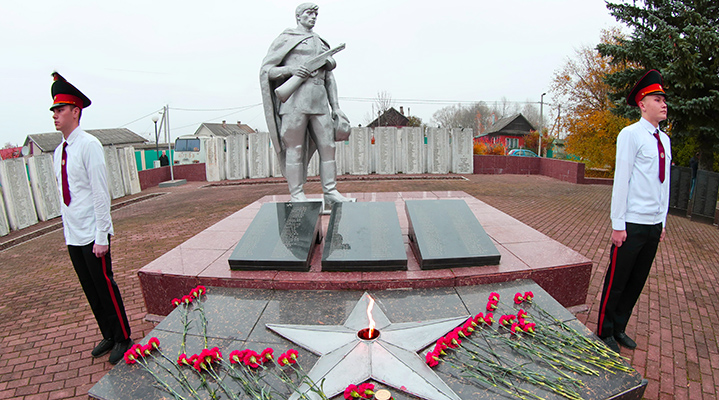
The common grave of soldiers-liberators in Vetka keeps the memory of the heroes who fell during the Great Patriotic War. More than 870 people, including soldiers of the 197th Bryansk, 96th, 250th, 287th and 307th Infantry Divisions, and 1st Tank Corps, rest in peace here. They died in 1943 in the battles to liberate the town and region from the Nazis. A sculpture of a soldier with a lowered banner and a stele with the names of the dead was erected here in 1975.
Address: Sovetskaya street
Khalch estate
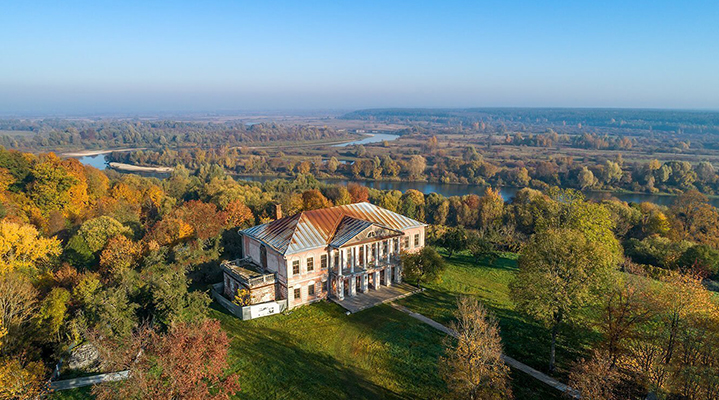
Very close to Vetka, on the opposite bank of the Sozh, is the village of Khalch. This place boasts a rich history as well. Since ancient times, the legendary Rodimichi settled on a huge sandy headland on the Sozh River. Khalch was first mentioned in the chronicles in 1437: Prince Svidrigaila gave the estate to nobleman Pavel Mishkovich whose children later took the name Khaletsky after the village. In the late 17th century, Kazimir Khaletsky, a very prudent and pragmatic owner, made a decision that changed the fate of the area. He invited the Old Believers, who founded a town and turned it into a flourishing region within a few years.
At the turn of the 18th-19th centuries, the Khaletsky family decided to build a new residence. A mini-palace was erected in the style of late classicism. There was not enough money to build it, so the first floor was built of stone, and the second one was made of wood and plaster (much later it was rebuilt). A mansion of the type is a rarity in Belarus. The facade facing the river was made especially elegant; the upper terrace on eight columns seemed to continue the ballroom, and from the lower one, two side stairs led to a beautiful park. Inside, however, the residence was not so luxurious, featuring small guest rooms and bedrooms, and the ballroom of a modest size.
From the mid 19th century to the events of 1917, the estate was owned by representatives of the Voynich-Senozhetsky family, who decorated the estate. At that time it was full of antique mahogany furniture, collections of books, china, silver, carpets, and paintings by famous artists. There was even a special secret room where masonic meetings took place, as the owners were members of the lodge.
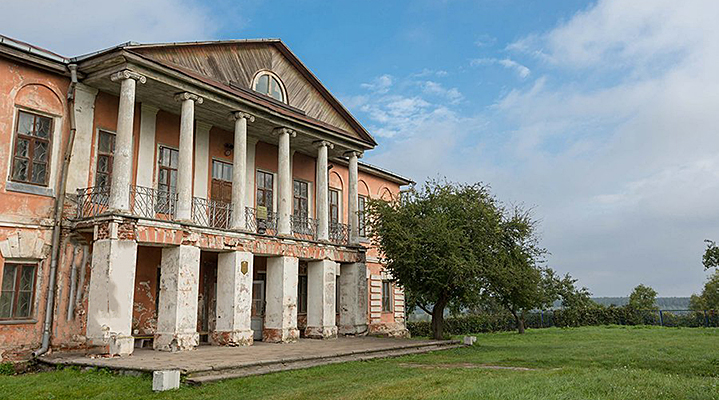
Khalch was full of life. The place had a church and a parish school, a Roman-Catholic church and a Jesuit monastery, a Jewish prayer house, an inn, several shops, and a large distillery. Large fairs were held twice a year. Smart landlord Sigmund Voynich-Senozhetsky arranged lavish balls and hunts, brought the first car from abroad and married a local beauty, who, however, ran away the day after the wedding…
After 1917 the nationalized estate housed a colony for homeless children, an NKVD prison, a club, and a collective farm office. During the Great Patriotic War Khalch witnessed bloody battles and many buildings of the estate were destroyed. Some parts of the estate have survived to these days. They are the two-storied palace, a manager's house, an orchard, and a park along the river.
Today, the old estate in Khalch is waiting for restoration works. There are plans to set up a museum complex here with an exposition in the style of the estates of the 18th-19th centuries, as well as a conference hall to host meetings and events.
Address: the village of Khalch
Vetkovsky Biological Reserve
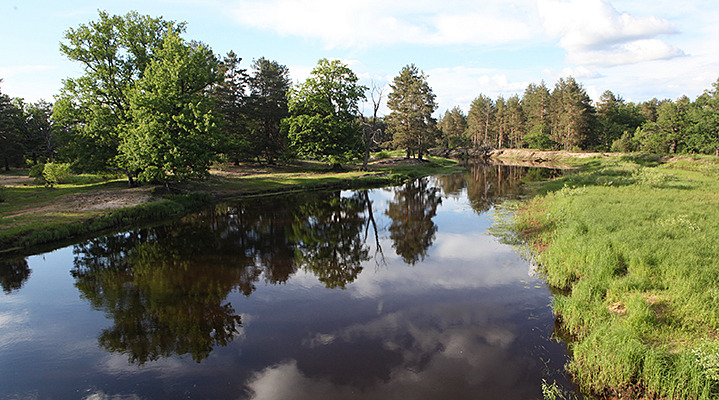
Vetka is located in the ancient land of Polesie - in a beautiful region, which is home to many almost untouched corners of nature. The Vetkovsky Local Biological Reserve was set up in the valley of the Besed River, which flows into the Sozh River, to preserve the unique natural complex. It protects over 30 species of plants (including medicinal herbs) and mushrooms and is the habitat of wild animals and birds included into the Red Book of the Republic of Belarus. It is forbidden to cut down trees in the area, so you can find century-old specimens here.
Plans are also in place to develop a wetland reserve of national importance “The Sozh River floodplain” in the vicinity of Vetka.


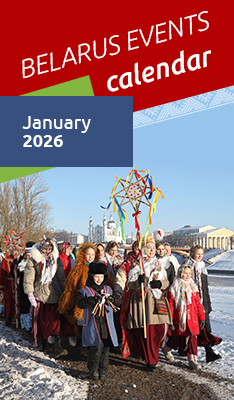




 print version
print version make home page
make home page add to bookmarks
add to bookmarks
